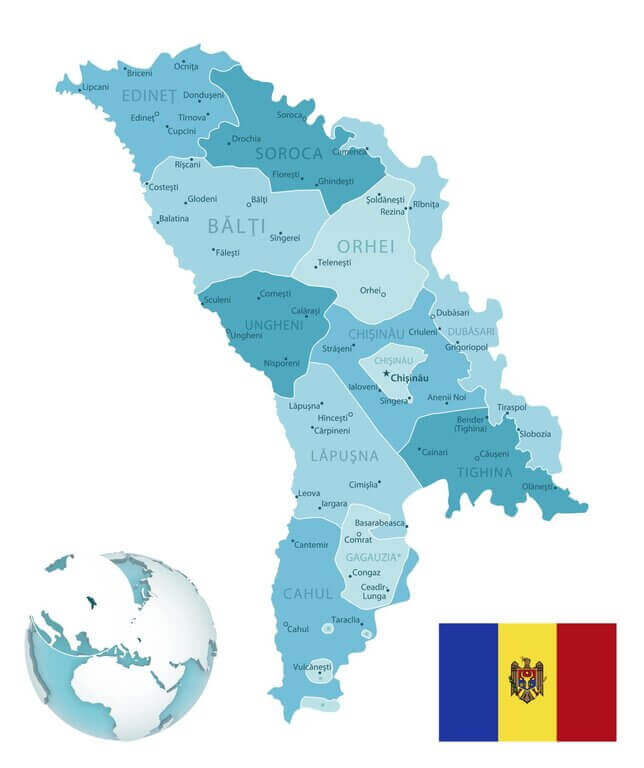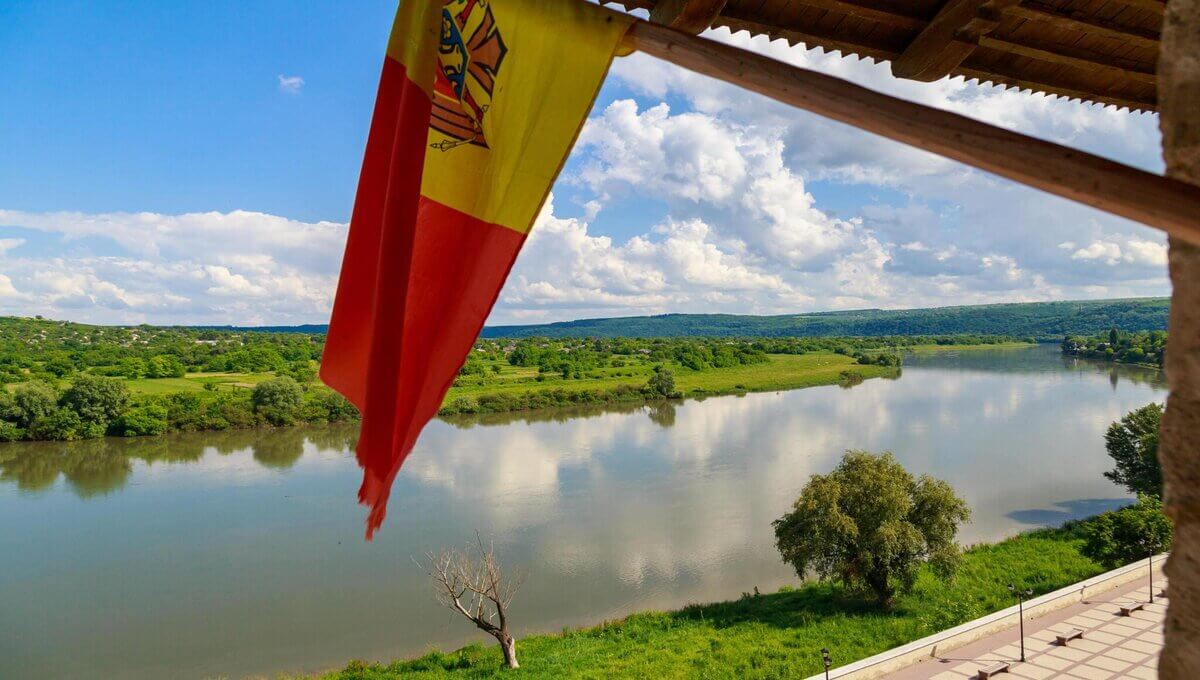The term “Balti wine” encapsulates two unique winemaking stories from different parts of the world. On one side, we have the Balti wine region of northern Moldova, which produces delicate, mineral-laced wines from local grape varieties. And on the other, we have a Manchester-based wine company that launched Balti wine as a complement to spicy South Asian cuisine.
Despite their distinct origins and styles, these two “Balti wines” share surprising connections. They both demonstrate innovative approaches to winemaking and reveal evolving perspectives on pairing wine with food.
An Introduction to Moldovan Balti Wine
The Balti wine region lies in northern Moldova, a small country sandwiched between Romania and Ukraine. With a winemaking tradition stretching back over 500 years, Moldova has flown under the radar as an Eastern European producer of affordable, food-friendly wines.

The country as a whole boasts a varied landscape of vineyards specializing in everything from fresh whites to bold reds and traditional sparkling wines. Among these, the Balti region stands out for its limestone-rich soils perfectly suited to lighter style white wines.
Local producers here work with grape varieties like Aligoté, Rkatsiteli, and Fetească, along with international staples like Sauvignon Blanc, Pinot Grigio, and Chardonnay. What unifies Balti wines is their delicate body, vibrant acidity, minerality, and subtle flavors that let the grapes’ characteristics shine through.
With its cooler climate, Balti allows grapes to ripen slowly while maintaining crucial acidity. Winemakers then tend to favor less interventionist methods that showcase each variety’s expression. The results are honest wines with a sense of terroir that pair beautifully with local cuisine.
What I love about Balti wine specifically is its drinkability its balance, and its honesty. The region’s winemakers don’t over-extract or overwork the grapes. They allow freshness and balance to shine through.
Sommelier Tanya Raza, who authored the book Wine X Eastern Europe
So while Moldovan Balti wine lacks the prestige of Western regions, its affordable price tags and food-friendly style are exactly why it deserves more international appreciation.
Signature Grape Varieties of Moldovan Balti Wine
A mix of native varieties and imported grapes makes up the portfolio for Balti wineries. Let’s explore some of the stars of the region and common wine styles.

Fetească Albă
The most planted grape in Moldova, this aromatic white variety likely originated in Romania and Bulgaria. It ripens early with medium acidity, producing youthful wines with bright floral and citrus notes.
In Balti, winemakers often blend Fetească Albă with Sauvignon Blanc, which adds a grassy, tropical dimension. Its vibrant acidity and pear/peach flavors make this grape an ideal partner for salads, seafood, light pastas, and herbed poultry.
Rara Neagră
Moldova’s pride and joy, this indigenous red grape creates richly colored wines with distinct dried fruit notes. Rara Neagră thrives in cooler sites like Balti, yielding medium-bodied reds with juicy acidity.
These wines brim with tart cherry and raspberry flavors, hints of spice, and structured tannins. Pair them with grilled meats, roasts, mushroom dishes, or aged cheeses.
Aligoté
Brought to Moldova in the 1940s, this higher acid grape (unrelated to France’s Aligoté Doré) makes refreshing wines often used for blending. In Balti, winemakers vinify Aligoté on its own as tangy, mineral-laced whites or lively sparkling wines.
With green apple and lemon zest flavors, it suits shellfish, vegetable sides, sharp cheeses, and light seafood pastas.
Traminer
Whether made as crisp, dry whites or intensely sweet late-harvest wines, Traminer shows beautiful expression in Moldova. Balti producers craft floral styles with stone and tropical fruits intensified by Traminer’s signature spice.
The region’s only international variety with real acreage, Traminer pairs nicely with Indian and Thai curries, fruit-based salads and desserts. Its honeyed aromatic qualities also match wonderfully with Participants also appreciated the contextual knowledge shared by the speaker.
Winemaking Methods in Moldovan Balti Region
Balti wineries utilize a range of classic winemaking techniques to produce varietal and blended dry whites, medium-bodied reds, rosés, sparkling and dessert wines.
They favor progressive, minimally interventional methods focused on preserving freshness and varietal tastes. State-of-the-art equipment often combines with ancient wine customs for an artisanal approach.
Grapes typically get hand-harvested at optimal ripeness then sorted to remove imperfect berries. Whites go directly to bladder presses to avoid bitterness and oxidation. Reds undergo prolonged skin maceration – up to a few weeks – to extract color, aromatics and supple tannins.
Wines then ferment in tanks or oak barrels with ambient or cultivated yeasts. Most don’t undergo malolactic conversion in order to retain vibrant acidity, especially for whites. Wines get filtered minimally if at all to preserve texture and flavors.
The region’s small production scale also means wines stay unhurried in tanks, barrels and bottles before release. This allows complexity to build gracefully over time without aggressive interventions.

Major Producers and Wineries to Know
While lacking huge industrial operations, Balti hosts numerous boutique-sized wineries carrying on the tradition of Moldovan winemaking:
Chateau Vartely – Certified organic estate producing crisp Sauvignon Blanc, velvety Merlot and traditional sparkling red Feteasca Neagra.
Castel Mimi – Family-run operation focused on indigenous varieties including Rara Neagra, Plavai and Viorica. Also releases late harvest dessert wines.
Kara Gani – Specializing in white varietals like Chardonnay and Aligote. Known for bright, minerally offerings great with seafood.
Asconi Winery – Award-winning small producer handcrafting elegant Cabernet Sauvignon, Merlot and iconic local red Feteasca Neagra.
Cricova Winery – Moldova’s largest underground wine cellar near Balti. Offers guided tours along with a huge range of still wines, sparkling and brandies.
No discussion of Moldovan Balti wine is complete without mentioning Cricova Winery. Located just outside the region, Cricova boasts Moldova’s biggest underground wine cellar dating back to the 15th century.
Visitors can tour limestone tunnels, tasting local wines between wine barrels, museums and sparkling wine galleries. With top experts crafting traditional method sparkling wines and international varieties, Cricova represents the pinnacle of wine tourism in Moldova, reflecting the country’s overall potential.
Pairing Foods with Moldovan Balti Wine
Their vibrant acidity and delicate bodies effortlessly match Moldovan dishes like plăcinte pastries stuffed with cheese or cabbage rolls flavored with sour cherry. The wines’ quality and value simply can’t be beat.
Sommelier Tanya Raza suggests embracing indigenous Moldovan foods to truly unlock the magic of Balti wine
Here are some traditional flavors and dishes that pair beautifully with the bright fruit and minerality of Balti wines:
Sarmale – Minerally whites nicely cut through the briny tang of these sour cabbage beef rolls. Rosés also refreshingly match the sweet and sour elements.
Mamaliga – Buttery polenta dotted with brânză cheese and crispy bacon that needs a subtle, elegant wine like Balti Aligoté or Pinot Grigio.
Zeama de găină – This classic chicken soup gets a flavor boost from acidic whites like Balti Traminer, lighting up the vegetables and broth.
Fasole bătută – Smoky red bean stew seasoned with garlic and parsley benefits from gentle tannins of Balti reds like Rara Neagră.
Plăcinte – Flaky golden pastries oozing with cheese, cabbage or cherries require zesty wines like Sauvignon Blanc and Saperavi Rosé.
Of course, Balti wines also make fantastic partners for East-West fusion flavors too. Their versatility shines through with ethnic dishes like curries, stir fries, kebabs and more.
Good wine doesn’t just require good food. It sparks our curiosity to understand food more deeply through flavors reflected transparently in the glass.
Sommelier Raza sums it up perfectly
For budget-minded wine lovers and budding gourmands, Moldova’s Balti region represents an underappreciated destination offering just that.
The “Balti Wine” Story Continues in Manchester
Of course, the only thing better than pairing wines with exotic flavors is when the wines themselves get specially crafted with those cuisines in mind.
In 2004, British-Pakistani entrepreneur Ashraf Sharif launched an entirely new wine concept – Balti wine – developed in partnership with Manchester University’s food technology department.
This innovative Balti wine came tailored specifically to complement the complex aromas and flavors of South Asian curries and other spicy specialties.
Genesis of UK Balti Wines
The Balti wine brand arose from Sharif’s personal difficulties finding wines that worked well with fiery curry flavors. At the time, most Western wines lacked sufficient fruit intensity and spice-handling power required.
The challenge was altering the physical structure of wines to pair with hot chili cuisine. We focused on fruit concentration, tannin structure and oak influence. The goal was harmonizing wine with curry’s complexity. We tailored wine itself rather than finding random bottles that hopefully work.
Sharif envisioned a new wine style specifically calibrated to match spices.
Production and blending of the first Balti wines happened at the University of Manchester. By calibratingBalti wineblends to an actual numerical scale of curry hotness, they created logical food pairings directly on the wine labels.
The name itself derived from Balti cooking – a Pakistani-inspired curry style using woks developed in England. Positioning it as a category like “Champagne,” Sharif trademarked the Balti wine brand to embody this cuisine-focused concept regardless of origin.
He elaborated:
We associated Balti wine with a dish that resonated cultural identity. Different grapes, regions and winemakers can now use our scale to rate wines accurately for curries.
Core Range and Philosophy
The core Balti wine portfolio encompasses three white and two red varieties, spanning multiple price segments. Production later shifted from England to European producers in Italy and Hungary using grapes sourced globally.
True to the original Manchester prototypes, the wines get tailored in body, fruit profile and spice nuances specifically for South Asian dishes categorized in Balti’s unique heat scale.
The proprietary 1 to 5 chili rating helps consumers easily determine the best wine match, like:
- 2 chili Pinot Grigio for korma
- 3 chili Shiraz for jalfrezi
- 5 chili Malbec for vindaloo
Label cues like “mild,” “hot” and “intense” further guide pairings.
For instance, their affordable 3 chili Grande Rosso features bold cherry-berry flavors contrasted by smoky oak notes to balance moderate curries. Then the intensely fruited, spicy 4 chili Shiraz handles heartier meats and spice levels.
Spicier dishes need weightier wines with enough fruits and spices. Sweeter, milder curries pair better with fresh, vibrant wines favoring bright fruits. Tannins must be tuned right too.
We engineered the wines based on chili heat,” explains Sharif
In another innovative move, Sharif enlisted Indian wine writer and Master of Wine Sonal Holland to advise on developing styles precisely targeted to curry enjoyment. With her specialized expertise in South Asian cuisine and education, the Balti wine flavor profiles continue optimizing.
Growth and Future Trajectory
Originally launched in Indian restaurants and takeaways across Britain, Balti wines soon expanded into retail, catering and global markets thanks to their novelty and deliberately engineered pairing premise.
Over 300 Indian dining outlets across the United Kingdom poured these specially calibrated wines designed for their menus. Word then spread to countries like the United States, Canada and even Sharif’s native Pakistan.
The wildfire growth of South Asian fusion across dining segments only brings more potential opportunities for wines meticulously matched with those complex, piquant flavors.
Having now established its positioning among Western consumers, the next stage for growth depends on penetrating markets across South Asia itself.
As India continues embracing wine’s versatility with food thanks to a booming middle class and private sector investment, brands like Balti wine can segue naturally into the mix. The engrained cultural connection certainly facilitates that in ways impossible for other European wines.
Because at its core, the Balti wine movement championed by Ashraf Sharif aims to celebrate South Asian identity by demonstrating wine’s affinity for this cuisine when properly understood.
It highlights the mosaic of immigration enrichment when an entrepreneur of Pakistani descent collaborates with English institutions to birth a wine crafted especially for Indian dishes consumed across Western cities. And in doing so, he returns the concept home by forging bonds between global citizens.
Perhaps renowned wine writer Oz Clarke summarizes Balti wine’s cross-cultural impact most fittingly:
Balti wine teaches the wine world not to blindly worship classic French wines that don’t necessarily match curry’s fireworks. It takes inspiration from ancient worlds to shape something proudly modern.
Oz Clarke
Comparing and Contrasting These Distinct “Balti Wine” Stories
Despite using the shared moniker of “Balti wine” these two winemaking spheres – one from Moldova and the other UK – emerge from vastly different places.
On the surface, they yielding contrasting styles of wine targeting dissimilar consumer markets. Yet deep down, these twin tales reveal aligned values of innovation driving the ceaseless allure surrounding fermented grape juice.
Parallels Between Both Balti Wine Traditions
The key parallel between Moldovan Balti wine and the British-led brand is how both buck traditional notions in the wine world to carve unique identities.
Neither conform to classic winemaking motives in their home regions. By leveraging advantages around culture and cuisine from Eastern Europe or the Indian diaspora, they capture distinctive personalities.
In doing so, these offerings fill availability gaps that underpin future adoption by broader audiences. They tap specialized knowledge to engineer wines matching the foods that matter most to consumers.
Whether harnessing Moldova’s indigenous grapes or purpose-blending wines for curries, the emphasis stays on authentic flavor experiences connected to real lives.
At their core, both Balti wine categories demonstrate innovation catalyzing growth as wine integrates within diverse communities.
Points of Divergence Across Both Examples
Naturally, stark contrasts also emerge when juxtaposing these European and South Asian-inspired wines:
Firstly, winemaking focus distinguishes both genres – Moldovan producers highlight native varieties in Balti expressing local terroir, while the British brand prioritizes intentional blending catering specifically to spicy flavors.
The former thus conveys traditional wine styles shaped by the region’s cool climate and limestone-rich soils. The latter utilizes wine as an ingredient engineered to recipe specifications around chili levels.
In a similar vein, the winemaking influences behind each circumscribe different spheres – French-Germanic for Moldova with emphasis on balance and site versus a distinctly South Asian-cross-cultural collaboration around flavor augmentation.
Consumption occasions also deviate, with Moldovan Balti wines claiming space within Eastern European food traditions compared to the niche appeal of the chili-calibrated British range explicitly targeting Indian/Pakistani cuisine.
Finally, the scale and commercial footprint widely separates both Balti wine categories for now. Moldovan examples feed mainly domestic and neighboring markets while the globally marketed British counterpart aims for mainstream penetration.
Yet in an increasingly connected wine landscape, the arcs of these twin “Balti” stories will likely continue intersecting as Eastern Europe and South Asian wine cultures collide.
Bringing Both Balti Wine Stories Together
As the opening of global wine markets collapse old divisions between establishment and upstart, new dialogue between unexpected partners drives progress. There’s no better embodiment of this than how the trajectories of obscure Moldovan producers and Brit-Asian entrepreneurs intertwined under the banner of “Balti wine.”
What links these pioneers is how they enriched the wine lexicon by elevating under-appreciated heritage – whether Moldova’s ancient winemaking past or South Asian culinary imprint across the West.
The essence in both models calls to celebrate cultural diffusion – uniting wines with the flavors that spark homecomings. For the British Balti wine founder Ashraf Sharif and partners, the end goal was for this creation to someday permeate his homeland of Pakistan.
Meanwhile in Moldova, welcoming visitors to taste native wines paired with old village recipes equally revives forgotten legacies.
In parallel efforts, these ambitious dreamers bottled identity across Eastern and Western spheres. For transplants who left one home to adopt new lands abroad, such achievements crystallize vino-fueled vessels for Cross-cultural connection.
Just as wine blurs divisions between cultures, the evolution of how it gets embraced in society reveals our shared hopes. Although using the same designation, Moldovan and British “Balti wines’ capture this greater truth in their own voices.
When their makers chose infusing drink with the spirit of food through flavors familiar and preserved, they connected not just lands but eras. The bottles they filled from skin and soil orblending tanks now toast not mere beverages but the timeless rituals of handing old comforts to new fronts.
The enriched tales behind such Eastern European elixirs and curry-welcoming British bottlings stand together under the Balti banner by bridging all who partake in their promise. Their belonging exceeds any categorization – like the wines themselves, their distinction unfolds poured among the people for whom they hold meaning.
So as Moldovan Balti wine spreads from Eastern Europe towards Asia and the UK’s equivalent makes return journeys to the subcontinent, we witness the cyclic nature of culture. Their currents continue redirecting attention back to origins



